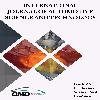Analysis of Design Parameters of a Novel Modified Reciprocating Mechanism
Analysis of Design Parameters of a Novel Modified Reciprocating Mechanism
In this study, displacement, velocity and acceleration equations were obtained for the mechanism created by modifying the long-stroke reciprocating mechanism. Thus, a novel mechanism has been created. In addition, the effects of the design parameters were examined and the results obtained were compared with the conventional crank-connecting rod mechanism. While the crank radius (r) and connecting rod length (L), which are the main design parameters of the conventional crank-connecting rod mechanism, are fixed, the design parameters of the novel mechanism are changed and the effects of these design parameters on the velocity and acceleration characteristics are examined. For the novel mechanism, the ratio of the inner gear radius to the pinion gear radius (r2/r1=k) and the ratio of the output gear radius to the pinion gear radius (r0/r1=m) are determined as the basic design parameters. Accordingly, by decreasing k and increasing m, it was seen that the connecting rod angle, mean piston velocity, and mean piston acceleration were decreased. The correct choice of k and m shows that the novel mecha-nism can be made more advantageous compared to the conventional crank-connecting rod mechanism. The results are predicted to be promising for engine designers.
Keywords:
Crank mechanism, Kinematics, Long stroke Reciprocate,
___
- [1] Ceccarelli, M. (Ed.). (2007). Distinguished figures in mechanism and machine science: Their contributions and legacies. Springer Science & Business Media.
- [2] Zhang, C., & Yang, J. (2020). Ancient Machines. In A History of Mechanical Engineering. Springer, Singapore.
- [3] Van Basshuysen, R., & Schäfer, F. (2004). Internal combustion engine handbook-basics, components, systems and perspectives (Vol. 345).
- [4] Rangwala, A. S., Amromin, E. L., & Kovinskaya, S. (2001). Reciprocating machinery dynamics: design and analysis. Appl. Mech. Rev., 54(5), B80-B81.
- [5] Atkinson, J. (1887). U.S. Patent No. 367,496. England: U.S. Patent and Trademark Office.
- [6] Yamada, Y. (2003). U.S. Patent No. 6,820,577. Tokyo: U.S. Patent and Trademark Office.
- [7] Catalano, G. (2017). WPO Patent No WO 2017/001986 Al. Lugano, China: World Intellectual Property Organization.
- [8] Gultekin, E., & Cinar, C. (2019). A thermodynamic com-parison of rhombic-drive and slider-crank mechanisms for a two-stroke SI engine. Energy Sources, Part A: Recovery, Utilization, and Environmental Effects, 1-18.
- [9] Yılmaz, E., Polat, S., Solmaz, H., Aksoy, F., & Çınar, C. Buji ile ateşlemeli tek silindirli bir motorda krank-biyel ve rhombic hareket mekanizmalarının termodinamik olarak karşılaştırılması. Gazi Üniversitesi Mühendislik Mimarlık Fakültesi Dergisi, 35(2), 595-606.
- [10] Kopystanski, G. (1999). U.S. Patent No. 5,934,243. Washington, DC: U.S. Patent and Trademark Office.
- [11] Nelson, C. D. (1985). U.S. Patent No. 4,517,931. Washington, DC: U.S. Patent and Trademark Office.
- [12] Hiyoshi, R., Nakamura, K., & Sugita, T. (2018). U.S. Patent No. 10,001,056. Washington, DC: U.S. Patent and Trademark Office.
- [13] Yang, S., & Lin, J. (2018). A theoretical study of the mechanism with variable compression ratio and expansion ratio. Mechanics Based Design of Structures and Machines, 46(3), 267-284.
- [14] Hiyoshi, R., Ushijima, K., Yasuda, Y., & Moteki, K. (2005). U.S. Patent No. 6,920,847. Washington, DC: U.S. Patent and Trademark Office.
- [15] De Witt, C. (1945). U.S. Patent No. 2,366,237. Washing-ton, DC: U.S. Patent and Trademark Office.
- [16] B2 Raffaele, P. R., & Raffaele, M. J. (2007). U.S. Patent No. 7,210,397. Washington, DC: U.S. Patent and Trademark Office.
- [17] Close, W. H., Szydlowski, W., & Downton, C. (1994). Perfect engine balance via collins Scotch Yoke technology (No. 941039). SAE Technical Paper.
- [18] Vaux, M. A., & Denner, T. R. (1994). U.S. Patent No. 5,331,926. Washington, DC: U.S. Patent and Trademark Office.
- [19] Heniges, W. B. (1984). U.S. Patent No. 4,485,768. Washington, DC: U.S. Patent and Trademark Office.
- [20] Rane, M. V., & Uphade, D. B. (2017, August). Novel Long Stroke Reciprocating Compressor for Energy Efficient Jaggery Making. In IOP Conference Series: Materials Science and Engineering (Vol. 232, No. 1, p. 012004). IOP Publishing.
- [21] Yadegar, I. (1996). U.S. Patent No. 5,528,946. Washing-ton, DC: U.S. Patent and Trademark Office.
- [22] Dunn, J. C. (1958). U.S. Patent No. 2,821,861. Washington, DC: U.S. Patent and Trademark Office.
- [23] McClure, K. S. (1984). U.S. Patent No. 4,430,902. Washington, DC: U.S. Patent and Trademark Office.
- [24] Senberber, G. (2013). Turkish Patent No. 2013/12131. Ankara, Turkey, DC: Turkish Patent and Trademark Office.
- [25] Senberber, G. (2014). Turkish Patent No. 2014/00721. Ankara, Turkey, DC: Turkish Patent and Trademark Office.
- Yayın Aralığı: 4
- Başlangıç: 2016
- Yayıncı: Otomotiv Mühendisleri Derneği
